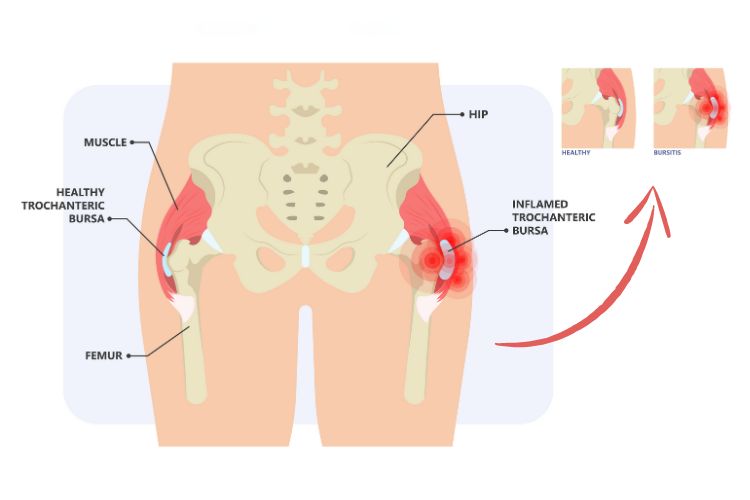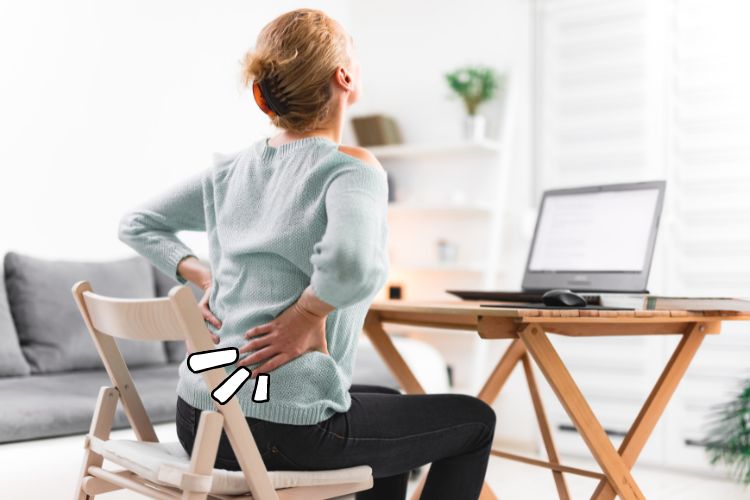Hip pain when sitting is a very common problem that can result in serious quality of life issues. In many cases, hip pain when sitting is caused by the sitting itself. If you live a lifestyle where you are sitting frequently on an uneven surface or with the wrong posture, a hip pain problem can begin. This can be stiffness in the hip, or the pain could become worsened with time.
When you can’t manage the pain on your own, or the pain goes too long, it may be time to see a doctor. That doesn’t always mean that you will need to have surgery or experience invasive treatments, but you may want to find out the cause of your knee pain. Treatments like more exercise and adjusting your sitting lifestyle at work can help bring relief to this hip pain every day.
Lower back pain and hip pain when sitting are common problems caused by extended hours of sitting. It’s natural to feel like these symptoms were your fault if you can’t help but sit for longer periods of time.
This is not necessarily the case. If you work in a job where you sit for long periods and work there for years, you may experience hip joint pain when sitting over time, regardless of your age or your lifestyle. This kind of lifestyle will result in less strength in your hips, joints, and muscles, and will cause pain. Learn more about hip pain when sitting and its causes and treatments here.
Causes of Hip Pain When Sitting
The anatomy of the hip is not as complex as it may sound, but any injury or strain here will cause hip pain when sitting. There are two main components of the leg that may cause hip pain when you are sitting. That is the femoral head of the knee as well as the acetabulum. The acetabulum is the socket inside the pelvic region that holds the hip, whereas the femoral head is the top of the thigh bone that fits in that socket.
Around these two components are important muscles, including the gluteals or buttock muscles. You also have the adductors, quadriceps, hamstrings, and iliopsoas muscle that starts in the small of your back. Then there are nerves around these components that when aggravated will feel pinched and cause pain.
The wrong posture could result in lifelong hip pain if it is not caught properly. If you are at a desk where you are hunched regularly, you may experience both hip and back pain. You will want to have proper support at any station when you are working in an effort to avoid hip strain that will cause a long-lasting hip condition.
Other sitting positions such as sitting cross-legged or leaning to the side regularly can cause hip pain when you are sitting. In some cases, a chair with an uneven surface will also cause hip pain or hip problems. You don’t want a chair that is too soft because your body will shift to the sides during the day. A chair that has you adding weight to your hips back and forth will also cause posture and hip or back issues.
Other conditions that may cause hip pain when sitting
Conditions like arthritis or bursitis are conditions that can cause hip pain that you will feel when sitting. These conditions are not necessarily caused by sitting as some others are. However, they’re conditions that will cause extraordinary burning and chronic pain. These conditions occur when there are cartilage issues to the joints, and bring wear and tear to your tissues and underlying muscles.
Bursitis is an inflammation of the fluid-filled sacs around the hip joints that works to prevent friction between the bones and tissues. When these sacs are damaged or inflamed, you will feel lower back and hip pain when sitting or sharp pain in the hip when sitting. Tendinitis is another condition that can make hip pain worse when sitting. This occurs when the muscles that are connected to the hip bones become inflamed or sore.
Some of the most common causes of hip pain are caused by age-related factors. Osteoarthritis, for example, is caused by a breakdown of the cartilage between the bones and is a factor of aging. Women will experience this more than men. Many conditions that cause hip pain when sitting are a natural effect of age, as the tissues and tendons in the body get worn out and begin to cause pain.
Identifying the cause of your pain will help you to relieve symptoms and get the right kind of treatment for your hip pain.
Symptoms of Hip Pain When Sitting
The symptoms of hip pain when sitting do not often vary by the condition. Hip pain can be an excruciating experience that prevents the patient from enjoying their quality of life. The pain is often described as a stabbing and shooting pain that can run the length of the leg. You might also have a weakness or numbness in the area that accompanies the pain. The joints and muscles may feel like they are too heavy to lift, because the pain is weighing you down.
In some cases, you may not feel the pain all of the time, but may only feel it when you are sitting. You may also begin to unconsciously restrict your own movements to avoid feeling this pain. The leg may feel stiff or you may experience tingling in the area of the pain.
The location of the pain will vary depending on what is causing the pain. So, you may feel pain only in the hip joint near the buttocks and thighs, and it may radiate to the back. This could be the case if you have a cartilage issue between the hip joint and the socket the bone goes into. If your pain is caused by pressure on the sciatic nerve, on the other hand, you may have pain that radiates down your entire leg. Hip pain can be an intense pain that needs to be identified and treated if it goes on too long.

Diagnosis of Hip Pain When Sitting
When you go to a doctor or practitioner to get your hip pain checked, there will be a number of tests performed to identify the location of your hip pain. Your doctor will also want to know your medical history in order to determine if lifestyle factors are contributing to your hip pain. It is likely that a wide range of diagnostics such as X-rays, MRI scans, CT scans, ultrasounds, and blood tests will be a part of your diagnosis.
In addition to medical histories and imaging for diagnostics, you may be asked to perform some exercises with your doctor. One of those is called the Patrick test, which is a physical test where the doctor looks at your range of movement. Gait tests are also often performed when there is hip pain.
Your doctor wants to see here what motions your hips can and can not do, and where you feel the most pain. There is no wrong way to walk here. The doctor is merely looking to diagnose and identify the underlying issue.
From here, you may be treated by your family doctor or referred to a specialist for a better look. You may see an orthopedic surgeon or a physical therapist, or be referred to for different regimens such as nutrition. Your treatment plan for hip pain when sitting will be determined once the cause is determined, and your motivation for therapy is discussed with you.
Treatment Options for Hip Pain When Sitting
There are many treatment options for hip pain when sitting. They may include exercise, relaxation, or medication. More advanced or intensive forms of treatment for hip pain when sitting include surgery and extended physical therapy.
Medication is a common first source of treatment for hip pain and will be dependent on the kind of hip pain that you have. Over-the-counter pain medication such as acetaminophen or ibuprofen will often help mild cases of hip pain when sitting.
You may need stronger forms of this kind of medication and be prescribed stronger acetaminophen or naproxen, which is another kind of anti-inflammatory medication with the NSAID family. It is possible you could also be prescribed muscle relaxants to help your muscles relax when sitting so that you do not experience extended pain.
Some at-home treatment methods could include lifestyle changes. You may need to lose weight if you experience hip pain too frequently. Massage therapy or compresses to the area can help. Both hot and cold compresses will work depending on your needs. Physical therapy and at-home exercises will also help tremendously. In extreme cases, surgery such as orthoscopy to scrape cartilage scarring, or a full hip replacement may be necessary.
Exercises for Hip Pain Relief
It is important to stretch and strengthen hip muscles that become sore when sitting. One way to do that is through low-impact exercises that you can do in order to help with your hip mobility.
One exercise is the hip flexor stretch that you can do from your chair. You can extend your legs back while holding onto the back of your chair. Rock your hips forward in order to feel the stretch in the front of your body. This keeps the hip flexor nice and warm and strengthened while sitting.
Hamstring stretches can be done from your chair while you are sitting. Straighten one leg at a time and lean forward until you feel the stretch. Remember to keep your knee straight so that you can feel the full stretch through your body.
Another stretch that you can do while sitting is to sit with your feet on the ground but bring an ankle up to the opposite knee. If you put pressure on your hand on this knee and lean forward, you can feel the stretch right back to your gluteal muscles.
Simple stretches, while you are sitting, can help you to feel better during the day if you need to sit a lot. These may go a long way towards relieving hip pain when sitting, but also preventing it.
Prevention of Hip Pain When Sitting
The prevention of hip pain when sitting is largely attributed to better posture when sitting. You want to make sure that you are always sitting on an even surface with your feet on the floor. Additionally, you want to be able to sit in a way where you can move around as much as possible and take breaks whenever possible.
Maintain a healthy lifestyle as well, and try to keep fattening snacks to a minimum when you are sitting for extended periods. When you are experiencing pain in the hip when sitting, try to sit in a way where you are not putting excess weight on your joints. Cushioning your joints when you can or bringing compresses to work or your chair can help tremendously as well.
Find Relief From Hip Pain
Hip pain when sitting is an excruciating experience that feels like it will never end. There are many known causes of hip pain and many different treatments for it. If the pain is unbearable or lasts too long, see a doctor to find relief.
Learn how to use some stretches right from your chair that can help you with your hip pain. You may also want supports to sit on that can help with your posture and bring relief. Ignoring hip pain won’t make it go away. Work to prevent it, but find treatment if you need to. Your awesome life awaits.
